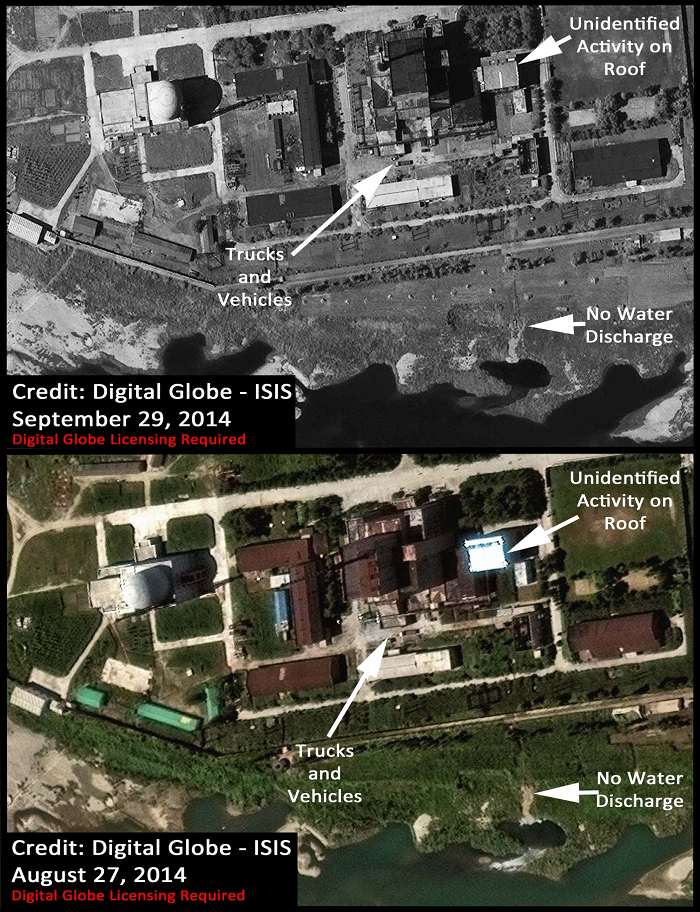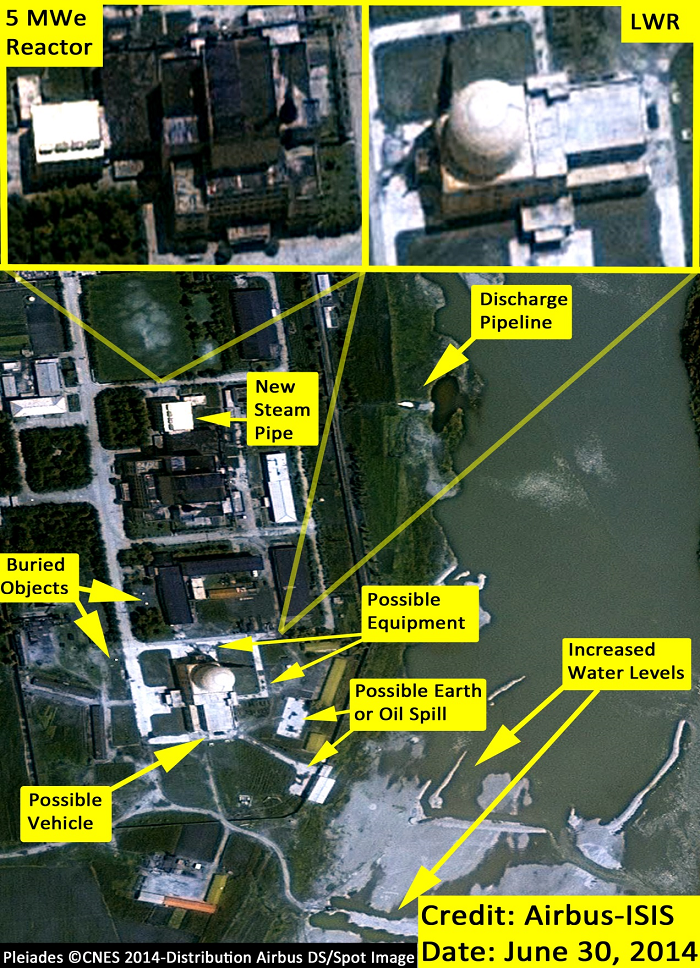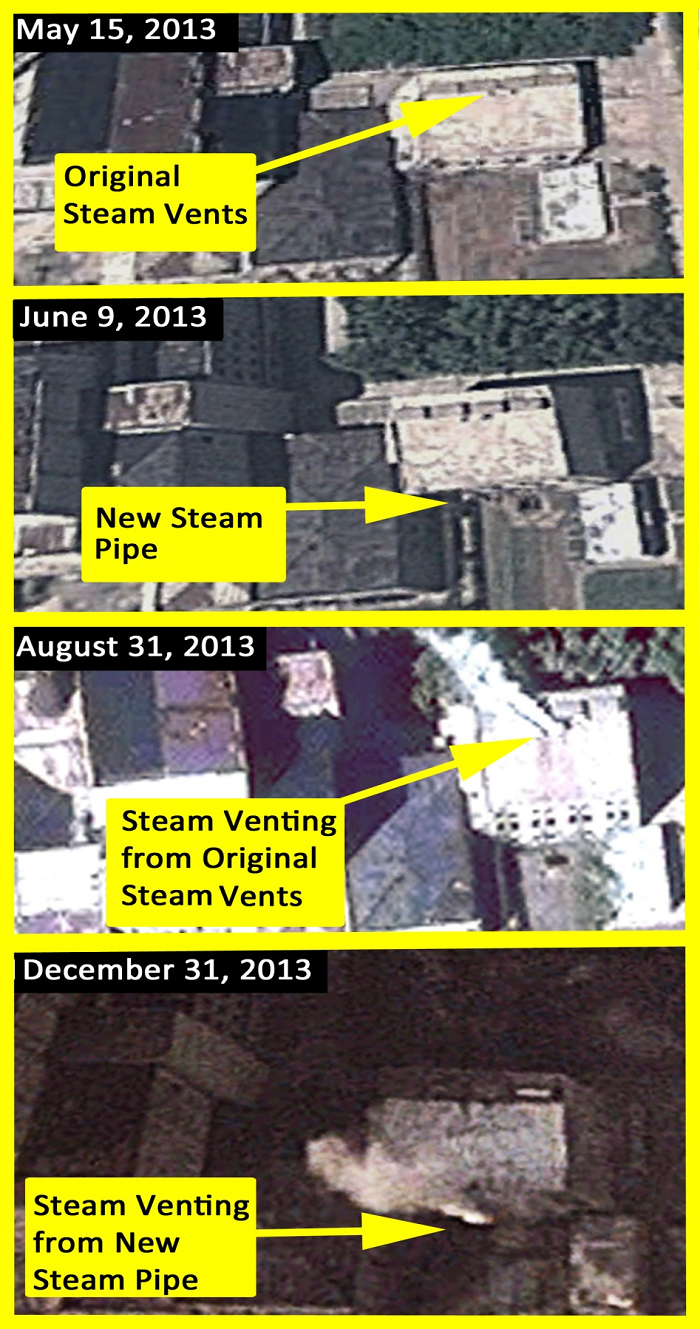Reports
Yongbyon: Centrifuge Enrichment Plant Expands while 5 MWe Reactor is Possibly Shut Down
by David Albright and Serena Kelleher-Vergantini
October 4, 2014
Commercial satellite imagery dated August 27 and September 29, 2014 show the possible shutdown of North Korea’s Yongbyon 5 megawatt-electric (MWe) reactor, possibly for either partial refueling or renovations. Roof renovations continue on a building adjacent to the uranium centrifuge building located in the southern part of the Yongbyon nuclear site. Analysis of imagery dated June 30, August 27, and September 29, 2014, combined with procurement data obtained by ISIS, suggests that North Korea is emphasizing the production of weapon-grade plutonium as well as enriched uranium for its nuclear weapons program. The start-up date of the experimental LWR continues to remain uncertain.
5 MWe Reactor
Since September 2013, ISIS has published several Imagery Briefs showing the on-going operation of the Yongbyon 5 MWe reactor (see ISIS Imagery Briefs with imagery dated September and December 2013, as well as April and June 2014). This assessment was based on the presence of either steam venting from the reactor’s turbine building or water being discharged into the river through a pipeline buried east of the reactor. ISIS assesses this discharge is part of the 5 MWe reactor’s secondary cooling system. The primary cooling system involves carbon dioxide. The water in the secondary cooling system cools the carbon dioxide gas heated by the reactor’s operation, producing steam for electricity production and hot water that is discharged into the river.
However, in imagery dated August 27 and September 29, 2014 both these signatures are missing (see figure 1). There is no steam venting from the turbine building and no water is being discharged from the secondary cooling system’s discharge pipeline. For this reason, ISIS assesses that it is possible that the reactor is partially or completely shut down.
The precise reason for this shut down is unknown. Although it appears early for a total core refueling, it is possible that North Korea is carrying out a partial refueling of the reactor’s core. Some fuel rods may be defective and are being replaced. Fuel could be shuffled within the core with some removed and new fuel inserted. It is unlikely that the entire core is being removed, since the reactor restarted only about a year ago, according to earlier analyses of satellite images. One would expect the core to remain inside the reactor for at least a few years, based on the reactor’s operational history. After a year’s operation, the core could contain up to 3-5 kilograms of weapon-grade plutonium. When the core is replaced, it would be expected to contain roughly double these amounts, depending on the operation of the reactor. Of course the question of refueling requires closer scrutiny, because the plutonium would be expected, after separation in the Radiochemical Plant, to be assigned to nuclear weapons.
Alternatively, it is also possible that North Korea has shut down the reactor for maintenance or renovation purposes. As figure 1 shows, unidentified activity is taking place on the roof of the reactor’s turbine building. In addition, one long open bed truck and a few other smaller ones are present near the reactor.
In August 2014, ISIS assessed that North Korea had apparently made a decision to renovate the aged 5 MWe reactor to make plutonium for nuclear weapons. As figure 3 shows, North Korea has apparently remodeled the reactor’s secondary cooling system, including replacing a steam line out of the reactor (between May and June 2013 North Korea installed what appears to be new piping).
For the last few years, North Korea has been procuring equipment for the 5 MWe reactor. These procurements are related to replacing aging equipment in this reactor and ensuring that it can manufacture additional fuel for it.
Experimental Light Water Reactor
The start-up date of the reactor remains unclear. North Korea has not updated information about this reactor during the last few years and satellite imagery shows no signs of activity or even movement of objects at the site. However, activity may be occurring inside the building; and some foreign procurements continue for this reactor. Thus, North Korea is expected to operate this reactor at some point.
A senior North Korean nuclear official stated in late 2011 that the reactor was expected to be finished by late 2012 or early 2013, although he acknowledged that finishing the reactor would be difficult. However, the reactor is still not operational and the available satellite imagery does not provide a reliable basis to estimate when the reactor may start. But the delays in operation raise the question of whether North Korea has experienced difficulties finishing the plant or is less committed to its completion.
Centrifuge Plant
The latest imagery shows that North Korea continues its roof renovating activities adjacent to the Yongbyon centrifuge plant located in the southern border of the site. North Korea has stated that this enrichment plant is dedicated to making low enriched uranium (LEU) for the LWR but it is also suspected of being involved in to the production of low enriched uranium that is intended for further enrichment to weapon-grade at this site at Yongbyon or at another centrifuge plant located elsewhere.
The most recent imagery dated August 27 and September 29, 2014, shows that North Korea has continued to renovate additional sections of the roof of a building adjacent to the main centrifuges building (see figure 4). Also, a train with flat cars carrying unidentified objects is visible on the tracks to the east of the site.
In August 2013, ISIS showed that North Korea nearly doubled the size of the gas centrifuge building and that in December 2013 it had renovated an additional section of the old roof of the centrifuge building. Imagery from April and June 2014 showed no signs of external construction activity at the centrifuge building are present, but there were several other signs of activity nearby (see figure 4 or here).
It is likely that North Korea has installed centrifuge cascades inside the new section of the centrifuge building. However, it cannot be determined whether North Korea has finished the expansion of this centrifuge plant.





 twitter
twitter